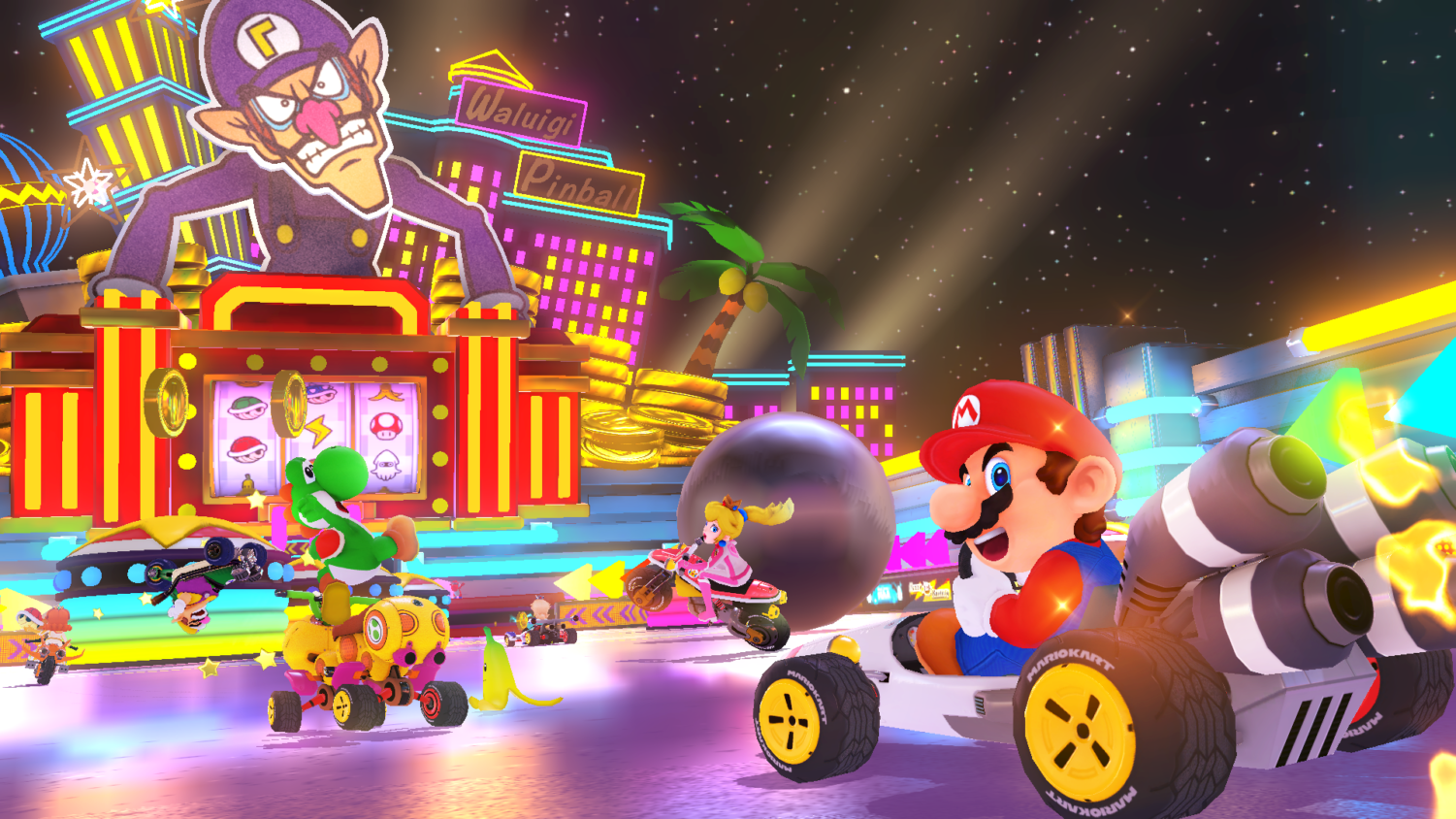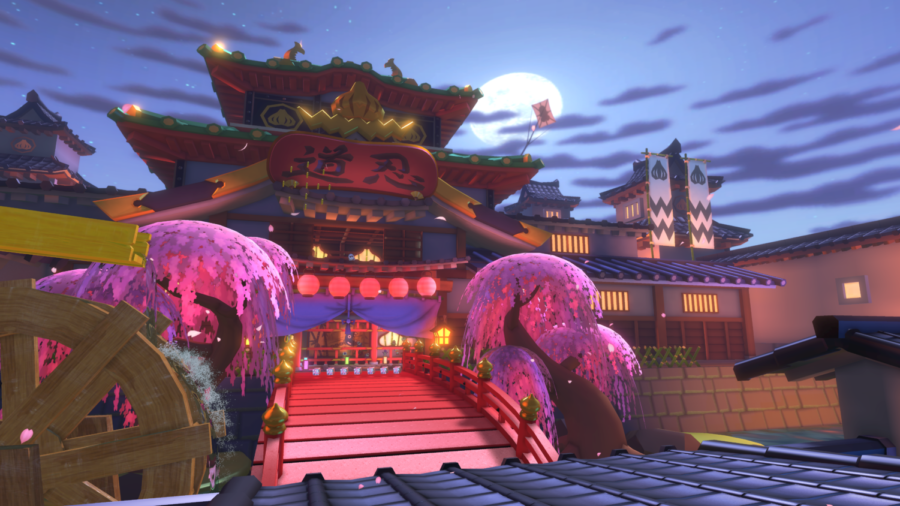Nintendo reinvigorates “Mario Kart 8 Deluxe” with waves of new race tracks
A review of the 16 tracks released so far
The drivable routes stacked on top of each other in Ninja Hideaway indicate that Nintendo is experimenting with new styles of tracks unlike the very linear layouts of old ones.
October 7, 2022
Fans of the Mario Kart franchise have spent years clamoring for Nintendo to release “Mario Kart 9” to no avail. In 2014, Nintendo released “Mario Kart 8” for the Wii U, and in 2017 Nintendo made “Mario Kart 8 Deluxe” (MK8D), an enhanced version of the same game for the Nintendo Switch. MK8D soon became the best-selling Nintendo Switch game of all time. Nevertheless, it has been eight years since the release of the last unique Mario Kart iteration for a gaming console—though in 2019 Nintendo released a mobile game called “Mario Kart Tour” to mediocre reviews.
Nintendo revealed that the company has not given up on improving MK8D when it announced the “Booster Course Pass DLC” on Feb. 9. “DLC” stands for “downloadable content,” referring to extra content that can be downloaded separately from the purchase of the main game—usually at a cost. In the case of MK8D, this means that for $24.99, a player can purchase the Booster Course Pass—a bundle of race tracks “with eight courses to be released at a time over six waves by the end of 2023.” Two waves of the DLC have been released so far, with a third wave coming this holiday season.
Each wave of the DLC is released in two Grand Prix of four tracks each, with 16 DLC tracks currently available.
The Golden Dash Cup—Wave One
This Grand Prix begins with Paris Promenade, a track from “Mario Kart Tour.” It is a scenic track that involves driving past famous landmarks such as the Eiffel Tower and Luxor Obelisk. Like all of the tracks based on real cities, Paris Promenade forces players to take different routes depending on the lap; after entering the third lap, players have to take a U-turn and drive facing the racers who are lagging behind. There is only one shortcut, which requires a mushroom to boost under the Arc de Triomphe. Overall, it is a solid track with good music whose simplicity should present few challenges to new players.
7/10
Next comes Toad Circuit from “Mario Kart 7” for the 3DS. This is the weakest of all the wave one DLC tracks. It is colorful to the point of lacking any appealing textures; for example, the grass is a uniform shade of lime green. However, Toad Circuit has some nice off-road shortcuts near the finish line, but complexity is sorely lacking from its straightforward layout. It can be a good track for new players who are still learning the basic mechanics of driving. The track does not contain anything else worth mentioning.
4/10
The third track on this Grand Prix is Choco Mountain from “Mario Kart 64” for the N64. This is the oldest track in the wave one DLC, released in 1996. It is a pretty and nostalgic track with much to enjoy. It contains great music, long round turns, a stunning cave section and falling boulders to crush unsuspecting racers. There are only a few shortcuts through patches of mud, but the track still requires skill in order to navigate the spiral cliffside turn where boulders fall. Choco Mountain is one of the highlights of the Booster Course Pass and is a great experience for novice and veteran players alike.
8/10
The Grand Prix ends fittingly with Coconut Mall from “Mario Kart Wii,” one of the most beloved tracks in the whole franchise. The music for the track is exceptional and the graphics are gorgeous. However, many fans complained that Nintendo removed the moving cars from the end of the track. The cars were made to move again with the release of wave two, but now they drive in occasional doughnuts instead of constantly back and forth in a straight line. Nevertheless, this DLC version of Coconut Mall retains almost all the charm it possessed in the original Wii version and is a huge boon for anyone looking to buy the Booster Course Pass.
9/10
The Lucky Cat Cup—Wave One
The second Grand Prix of wave one begins with Tokyo Blur from “Mario Kart Tour.” The track is certainly a blur and ends in no time at all. Racers start on the Rainbow Bridge and soon see Mount Fuji in the distance, both famous Tokyo sites. This track has a different route for each lap, but is relatively plain with few shortcuts—though Nintendo includes some Thwomps to crush racers. The music is exciting, but it does not make up for the simplicity and brevity of the track. In the end, Tokyo Blur merits nothing more than an average ranking.
5/10
Nostalgia returns as racers move to Shroom Ridge from “Mario Kart DS.” Its calm music belies the fact that this is one of the craziest DLC tracks to navigate. Players have to drive through a series of extremely tight corners that provide no visibility as cars and trucks try to hit them. Nintendo also spiced up the course by adding a very difficult shortcut near the end that involves jumping over a chasm. Shroom Ridge is a nightmare for new players and a welcome challenge for skilled ones, making this track an exciting experience for any group of players.
8/10
Next comes Sky Garden from “Mario Kart: Super Circuit” for the Game Boy Advance. Strangely, the layout of the DLC version of Sky Garden bears no resemblance to the original track, and, like Tokyo Blur, this track suffers from being too short. The music is mediocre for a Mario Kart game, though the track has a surprising amount of simple shortcuts. Mario Kart veterans who played the original version will be disappointed to see this track has been changed completely, and does not provide anything special or exceptional.
5/10
The last of the wave one tracks is Ninja Hideaway from “Mario Kart Tour,” and it is the only DLC track from that game not based on a real city. This track immediately and almost ubiquitously became a fan favorite—the music is thrilling, the visuals are outstanding and the layout is unprecedented. Throughout the race there are multiple drivable routes laid on top of each other. This feature gives players a plethora of options when they race since they can decide where they would like to drive at any moment. Without a doubt, this track is a major selling point for the Booster Course Pass and an incredible experience for all players.
9/10
The Turnip Cup—Wave Two
The first track of wave two is New York Minute from “Mario Kart Tour.” The course is visually stunning and takes racers around landmarks like Central Park and Times Square. New York Minute changes its layout between laps. The track has few shortcuts, and, unfortunately, Nintendo chose to make the course extremely slippery, resulting in players having a very hard time driving precisely. The lack of good traction can make the track miserable for new players and annoying for experienced ones. The visuals and the presence of some obstacles on the road make up for the track’s bad traction and relatively simple layout.
6/10
Next comes Mario Circuit 3, a track from “Super Mario Kart” for the Super Nintendo Entertainment System (SNES). This track has plain, bright visuals and a huge nostalgia factor since it also appeared in “Mario Kart Wii” and “Super Mario Kart,” released in 1992. Mario Circuit 3 is full of curvy turns and a monumental amount of sandy off-road, making it an amazing track for comebacks as players can use items to cut through massive portions of the desert. The nostalgic music of this track combined with its simplicity and game-breaking shortcuts make it an enjoyable experience for all levels of play.
7/10
More nostalgia follows with Kalimari Desert from “Mario Kart 64” and later “Mario Kart 7.” Like all desert tracks, this one is full of off-road shortcuts through the sand, but Nintendo decided to change the track drastically by making all three laps different. After a normal first lap outside in the desert, the second lap forces players to go through a tight tunnel as trains barrel toward them, while the third lap resumes outside of the tunnel as players dash to the finish line. The sunset desert aesthetic of the track is beautiful and the music is fitting. This is simply one of the most exciting tracks to come from the Booster Course Pass.
9/10

This Grand Prix ends with Waluigi Pinball from “Mario Kart DS” and later “Mario Kart 7.” This iconic track can only be criticized for its lack of shortcuts, but every other facet of the track is indisputably extraordinary. The music is invigorating, the visuals and colors are sublime and the difficulty of the track is high. The many sharp turns bedeviling inexperienced racers and numerous giant pinballs smashing into players at lightning speed make this track simultaneously grueling and exhilarating.
10/10
The Propeller Cup—Wave Two
The last Grand Prix of the released DLC waves begins with Sydney Sprint from “Mario Kart Tour.” Out of all the city tracks, this one is by far the longest and most complicated. Each lap takes on a life of its own and hardly resembles the one that preceded it, featuring major landmarks such as the Sydney Opera House and the Sydney Harbour Bridge. The track has some nice off-road shortcuts and good music, but it completely lacks obstacles. The fact that the laps are so different can make it difficult for new players to learn the track. Though Sydney Sprint has some shortcomings in its long open roads, it makes for an enjoyable race.
7/10
Then comes Snow Land from “Mario Kart: Super Circuit.” Like all icy tracks, the traction on this one is horrible, making the track slippery and precise driving difficult. Snow Land is notable for the massive mushroom shortcut near the start of the race that almost looks like an unintended feature. The track also has two mushroom shortcuts through the snow before the finish line. Penguins slide through parts of the track as obstacles. Overall, the music and visuals are unexceptional. Snow Land involves a surprising amount of skill for such a seemingly simple track.
6/10
The third track in this Grand Prix is the iconic Mushroom Gorge from “Mario Kart Wii.” Nintendo succeeded in retaining all the old charm of this track in its DLC version. Most of the Mushroom Platforms (green) and Trampolines (red) are in the same spots with the addition of a blue Mushroom Trampoline that activates the glider. The mushroom shortcut over the last gap is retained in this version. The music is invigorating and the visuals are beautiful, especially in the cave section illuminated by blue and pink crystals. Nevertheless, hopping over the Trampoline Mushrooms can sometimes lead to players falling off, even when they drive well. Mushroom Gorge on MK8D is still an amazing experience and a great track for Nintendo to include in the Booster Course Pass.
9/10
The last of the current DLC tracks is Sky-High Sundae, a track first released with the Booster Course Pass but later added to “Mario Kart Tour.” The track is extremely colorful and takes players on a race across ice cream and confectioneries. It includes a difficult yet rewarding shortcut that involves drifting off the semicircle of ice cream scoops. The bright visuals are striking and the music is rousing. There are no obstacles on the track, but it is easy to fall off since there are no railings. Sky-High Sundae is fun for anyone to play, and its creation is a hopeful sign that Nintendo may make more tracks from scratch for future DLC waves.
7/10



